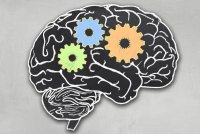Helping Students Develop Executive Function Skills
Simple classroom strategies can assist students with deficits in executive function skills like time management and active listening.
Executive function is an umbrella term in neuroscience to describe the neurological processes involving mental control and self-regulation. Executive functions control and regulate cognitive and social behaviors like controlling impulses, paying attention, remembering information, planning and organizing time and materials, and responding appropriately to social situations and stressful situations.
Experts believe executive function is regulated by the frontal lobe of the brain—the prefrontal cortex. Because humans are born with brains that are not fully developed, children are not born with these skills, but they have the potential to develop them.
Some students do not develop executive functions to the same degree as their peers. For these students with deficits, additional support in the classroom may improve their development of executive function.
Offering Teaching Support
Addressing a deficit requires understanding the type of deficiency the student faces. If a student lacks knowledge, he or she does not know what to do or how to do a task. For example, if students lack the ability to regulate their impulses to speak while others are talking, the behavior of active listening should be explicitly taught by identifying examples of active listening. Educators might also create a chart with what it looks and sounds like when students are engaging in active listening.
A student may know what to do to complete a task, but may have trouble knowing when and how to apply the appropriate skills. For a student with this type of deficit, the teacher may confirm that he or she has all the required materials to complete a task. The teacher could provide a checklist with the necessary materials. For older students, the teacher could ask the students to generate the list and then gather the appropriate materials.
Metacognition: Another strategy for addressing deficits in executive function is using metacognitive language. For example, with a younger student, articulating the challenge could be useful. “I see that you are missing a pencil. You will need a pencil to complete the assignment. Where could you find one in the classroom?”
Displaying the steps or questions that students could ask themselves in the classroom is also helpful to promote independence with a skill. Students can repeat directions to a partner and then have a volunteer repeat the direction for the whole class. This process takes less than a minute but allows additional time for auditory processing and repetition for any students who may need it.
Time management: Posting schedules can be a useful tool in developing time management skills. A classroom schedule outlines the entire day and prepares students for what’s coming next. An activity schedule breaks down a block of time into smaller chunks and outlines how each period will be used and in what order activities will be presented. These schedules are commonly placed in spots where every student can refer to them during the day.
Long-term assignments can be particularly challenging for students with deficits in executive function. One way to address this issue is by directly teaching students how to map out larger projects and break them down into smaller, more manageable pieces. Use a calendar to determine when each smaller assignment will need to be finished, and place the smaller benchmark goals on the calendar.
Review before new learning begins: Provide opportunities for students to review previous learning. This review may be a quick oral presentation, or teachers can pair students and have them share what they remember from the previous day.
A review might also take the form of a mind map or concept map created in small groups. Concept maps are useful graphic organizers for note taking, comparing/contrasting, and writing. Graphic organizers can be particularly helpful for students with executive function deficits because organizing thoughts can be as difficult as organizing time and materials.
Teacher interaction: Teacher behavior is also influential in supporting students who may have deficits in executive function. Teachers should check in frequently with students who are known to have deficits and provide discrete support when needed. In addition, having a caring demeanor and using positive reinforcement with students with deficits can positively affect their school experience.
Offering Environmental Support
Environmental support means creating a space where children can thrive. Some easy ways to help students improve executive function include:
- Post a daily schedule. Clear and consistent routines and procedures offer structure to students.
- Provide visual supports such as posters with problem-solving steps or routines, and color-coded schedules and folders. Consider highlighting key words and ideas in texts.
- Minimize clutter and create clearly defined areas in the classroom.
Potential for Growth
Executive function takes time to fully develop, and it develops at different rates in different children. The prefrontal cortex of the human brain is constantly growing and changing in young children as well as adolescents. Because of the human brain’s plasticity and enormous capacity for learning, it is possible to improve the executive functions of students with deficits through classroom strategies and support.
